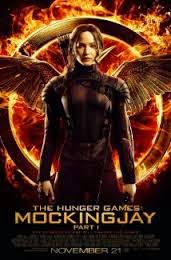When the improbably titled The Hunger Games: Mockingjay Part One came out in November, my oldest daughter who is a big fan of the books asked, “Why do they keep taking one book and chopping it up into two or three movies?” My daughter is only 13 but even she recognizes you can read all of Tolkein’s The Hobbit in less time than it takes to watch three three-hour long Peter Jackson Hobbit films. Anyway, it’s always a tender, special conversation when a dad gets to explain the birds and the bees of Hollywood filmmaking to his teenage daughter. It begins something like this: “Well, honey, when a movie studio loves money very, very much, it will do pretty much anything possible to get more of it.”
Sometimes a book is large enough to warrant two films. Harry Potter and the Deathly Hallows
falls under that category. But mostly, the splitting-the-final-book strategy is
purely about greed. I explained to my daughter that if there was one Mockingjay
film, it would come out at the holidays, make several hundred million dollars in
domestic box office, generate several hundred million more overseas, and then,
in a few months, make one last big chunk of cash on DVD, Blu Ray, and
streaming. But with TWO films, the studio can make all that same profit this
year and then do the exact same thing again next year.
It’s avaricious, calculating, and artistically questionable
– but there’s never been a time that hasn’t been an accurate description of
Hollywood studios. So much of what we think of as standard practice for movies
was shaped by the quest for profit. How long is your average movie? About an
hour and a half to two hours, right? Why? Because studios figured that’s the
ideal amount of time to get the maximum number of shows in the theater.
Technical developments like 3-D, widescreen, surround sound, IMAX? All created
because theaters were losing customers to TV and they needed something to set
themselves apart from the boob tube.
As far as Mockingjay
Part One goes, it doesn’t stand well on its own. As ever, Jennifer Lawrence
continues to be America’s sweetheart and convey an inherent sense of decency
while being simultaneously distraught and confused. Phillip Seymour Hoffman
makes one of his final appearances and, even though he could very well be
phoning it in, he’s still better than 80% of everyone else in the movie. The
production values are higher in this film than in the previous two and the
money is clearly on the screen which is nice to see.
But the movie never really comes to any kind of narrative
boil. With a few exceptions, it’s essentially two hours of Katniss being deeply
concerned about stuff. The film corrects the limited point-of-view that
hindered the novel and allows the viewer to see rebellion-fueled unrest growing
in other districts and to hear conversations that the main character isn’t
privy to. But ultimately, the whole film just feels like a pre-game show. It’s
nice to look at and exciting here and there, but it’s definitely not the main
event you tuned in for. Plenty of films, especially sequels, end in an
ambiguous, cliff-hanging kind of way, so it’s not necessarily that I have a
problem with where or how Mockingjay Part
One ends, it’s that the 122 minutes leading up to that ending didn’t feel
like enough to justify it. The cut-off isn’t earned.
So my daughter is now a sadder but wiser movie goer. She
knows the studios only care about her as much as it takes to lure the
babysitting money out of her purse and across the concession counter at the
local multiplex. She knows it and I know it, but we all know we’ll both be back
in theaters next November to see Part 2.

No comments:
Post a Comment